#ama no iwato
Text
Persistent Mythologies; Pt3, Gardens of Eden
Persistent Mythologies; Pt3, Gardens of Eden
Gardens of Eden
The successive warming and cooling periods of the various Dryas periods since the last Glacial Maximum have left folk memories in the traditions of the people of Eurasia.
Just as Australia has 15,000 year old folk myths of the last Glacial Maximum, Eurasia has its own oral history which goes back around the same length of time, or longer, before the invention of writing fixed…

View On WordPress
#Ama-no-Iwato#Amaterasu#Anatolia#Di Jun#Dryas#EO James#Epimetheus#Fusang#garden of eden#Hannahanna#Hephaestus#Hou Yi#indira#Josephus#King Yao#Nintud#Pandora#Ralph T.H. Griffith#Rig Veda#Robert Graves#Susanoo#Telipinu#Vritra#Xihe#Yi The Hero
1 note
·
View note
Text
Sean bienvenidos japonítasarqueológicos a una nueva entrega, en esta ocasión vengo a aclarar dudas sobre la diosa Amaterasu dicho esto comencemos.
-
Amaterasu aparece en los libros kojiki y Nihonshoki que son los más antiguos de Japón, dicha diosa simboliza el sol, la luz, la compasión y la verdad. Además Representa la casa real con la flor de crisantemo, también ha recibido otros nombres como: "Hirume" y "Mukatsuhime. Sus padres eran izanagi(dios creador de Japón) e izanami(diosa del infierno), izanagi al quedar contaminado de la tierra de Yomi fue a purificarse y al quitarse la ropa fueron naciendo los demás dioses y ella nació de su ojo izquierdo.
Amaterasu gobernaba el Takamanohara y su hermano Susanoo era el dios del mar.
-
Amaterasu, estaba asustada por su hermano menor y decidió esconderse en una cueva profunda en Takamagahara llamada "Ama no Iwato" y bloqueó la entrada. Este es el famoso “Amaniwato no Kamigakure”, que el pueblo japonés sigue recreado como una de sus muchas tradiciones populares.
-
Como ya hablamos en otras publicaciones el sintohismo, es una religión autóctona de Japón que durante la era Meiji sería utilizada para clasificar lo japonés y de lo que no era japonés, los japoneses nunca dejaron el sintohismo de lado. La simbología de la bandera japonesa se remonta desde tiempos muy remotos.
-
La diosa Amaterasu tiene unos 5000 templos dedicados a ella y se llaman Shinmei Jinja. El templo se localiza dentro del santuario Ise Jingu, también conocido como (oise-san) y el templo se llama Kotai jingu. En la ciudad de Iwato en la prefectura Miyazaki se encuentra el santuario Amanoiwato donde se dice que Amaterasu fue establecida como deidad principal. Amaterasu lo podemos traducir como: Diosa del sol o como diosa solar.
-
新作へようこそ、今回は天照大神の疑問を解き明かすということで、始めましょう。
-
日本最古の古事記や日本書紀に登場する天照大神は、太陽、光、慈悲、真実を象徴しています。また、菊の花で王家を表し、「ヒルメ」や「ムカツヒメ」などの別名も持っています。彼の両親はイザナギ(日本の創造神)とイザナミ(地獄の女神)でした。ヨミから大地を離れ、身を清めに行き、服を脱ぐと他の神々が生まれ、左目から生まれました。
アマテラスは高天原を治め、弟のスサノオは海の神でした。
-
弟を恐れたアマテラスは、高天原の深い洞窟「天の岩戸」に身を隠し、入口をふさいだ。これが有名な「天岩戸の神隠れ」で、日本人は多くの人気のある伝統の1つとして再現し続けています.
-
他の出版物ですでに説明したように、神道は日本固有の宗教であり、明治時代に日本人とそうでないものを分類するために使用されましたが、日本人は決して神道を放棄しませんでした.日本の国旗のシンボルは、非常に遠い時代にまでさかのぼります。
-
天照大神を祀るお寺は約5,000あり、神明神社と呼ばれています。このお寺は伊勢神宮内にあり、通称「お伊勢さん」とも呼ばれ、皇体神宮と呼ばれています。宮崎県岩戸市には天照大神を主祭神とする天岩戸神社がある。アマテラスは、太陽の女神または太陽の女神として翻訳できます。
-
Welcome to a new installment, this time I come to clarify doubts about the goddess Amaterasu, having said that, let's begin.
-
Amaterasu appears in the Kojiki and Nihonshoki books, which are the oldest in Japan, this goddess symbolizes the sun, light, compassion and truth. It also represents the royal house with the chrysanthemum flower, it has also received other names such as: "Hirume" and "Mukatsuhime. His parents were izanagi (creator god of Japan) and izanami (goddess of hell), izanagi when contaminated by the earth from Yomi she went to purify herself and when she took off her clothes the other gods were born and she was born from her left eye.
Amaterasu ruled the Takamanohara and her brother Susanoo was the god of the sea.
-
Amaterasu, scared of her younger brother, hid in a deep cave in Takamagahara called "Ama no Iwato" and blocked the entrance. This is the famous "Amaniwato no Kamigakure", which the Japanese people continue to recreate as one of their many popular traditions.
-
As we have already discussed in other publications, Shintoism is an indigenous religion of Japan that during the Meiji era would be used to classify what is Japanese and what was not Japanese, the Japanese never abandoned Shintoism aside. The symbology of the Japanese flag dates back to very remote times.
-
The goddess Amaterasu has about 5,000 temples dedicated to her and they are called Shinmei Jinja. The temple is located inside the Ise Jingu shrine, also known as (oise-san) and the temple is called Kotai jingu. In the city of Iwato in Miyazaki Prefecture is the Amanoiwato Shrine where Amaterasu is said to have been established as the chief deity. Amaterasu we can translate it as: Goddess of the sun or as solar goddess.
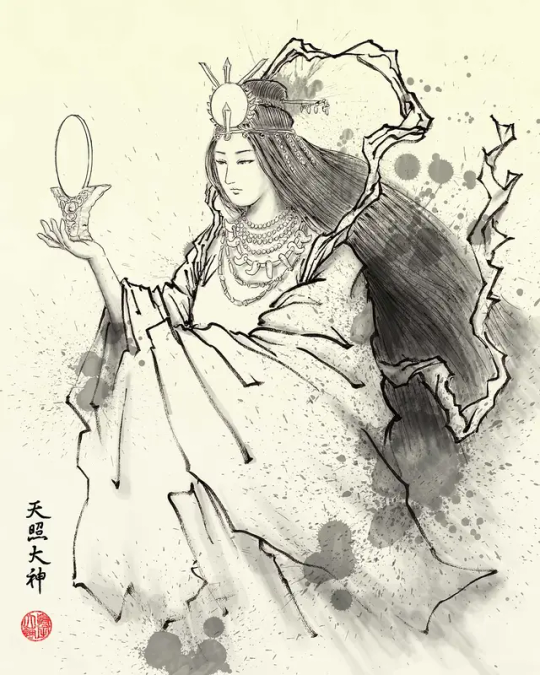
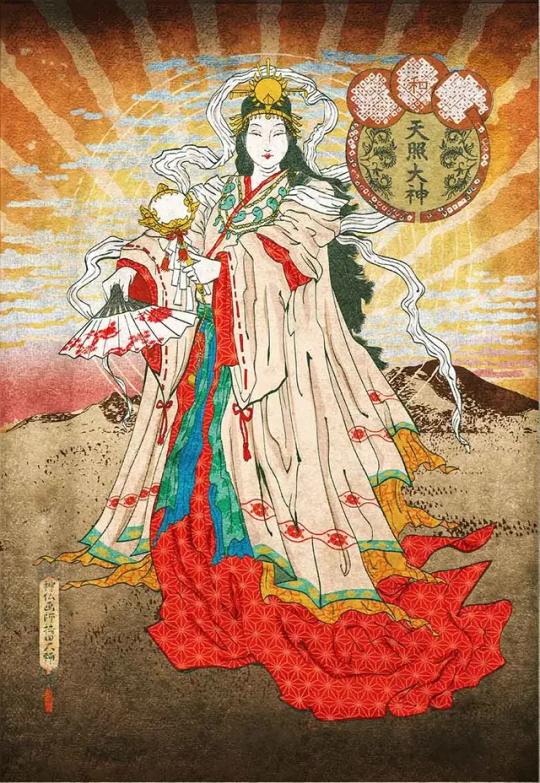
#日本#アマテラス#アート#写真#ユネスコ#文化#神話#神道#シントイズム#japan#amaterasu#art#photo#unesco#culture#mythology#synthology#sintoism
60 notes
·
View notes
Text
Jellyfish Can’t Swim in the Night uses the classic Japanese fable Ama-no-Iwato as a metaphor for character drama in its third episode, and it just so happened to air on the 18th anniversary of the release of the PS2 game Okami, which was inspired by the same fable.
8 notes
·
View notes
Note
I'm the one who sent you a question about the interview in Da Vinci magazine and the recent one about Kana. I enjoyed reading your opinion a lot, so I did a bit of scrolling back and reading everything.
I saw your post about how Akane and MEM were not supposed to stay after the Love Now arc some time ago, but I am 100% sure Akane and MEM were supposed to stick around after the main arc. MEM is another piece that is related to Aka's grand game of guessing the ending, so I will avoid talking about it for now (but I think you already knew about this since Nobuyuki did called MEM by the nickname of ME-san). I actually planned to discuss this with you, but laziness got to me until Sneaky pissed me off on 4chan, and I just kind of wrote about this topic (such impure motivation) there. I figured I should share this here as well.
For Akane, it is actually even more straight-forward than for Kana or Ruby. I used to ponder a lot about why Aka gave Ruby the Amaterasu line and Kana the image of the sun, but nothing for Akane. It doesn't really make sense because Aka is not the type who would give an easy answer to those actively seeking things behind his lies and riddles. In the sense of competition for who will end up with Aqua, not being linked to the image of the sun is a big red flag. In the more meta sense of children who are neglected by adults in the entertainment industry trying their best to shine and help others shine, it also doesn't make sense to have Akane never being put into the position of Amaterasu, even if there is only one real sun by the end of the story. The message should be that everyone can shine if they get help and are put into the spotlight. But eventually I arrived at the evidence that linked Akane to this whole Amaterasu/Sun thingy.
We start off with the real couple in Love Now: Nobuyuki and Yuki.
Nobuyuki Kumano (熊野ノブユキ). Nobuyuki is a name often written as 信幸 or 信行. If you read them in Onyomi, they are read as shinkou. The kanji for shinkou is 信仰. Together with his family name, Nobuyuki is a reference to the Kumano faith (熊野信仰).
Nobuyuki's lover is Sumi Yuki (鷲見ゆき). The action of visiting the three grand shrines at Kumano is called Kumano pilgrimage (熊野詣). This action has been taken successively by many Emperors of Japan throughout history. When this action is taken by the emperor, it is referred to as miyuki (御幸). So Kumano Nobuyuki x (Su)mi Yuki is a reference to the three grand shrines at Kumano. Among the three, there is Kumano Hongu Taisha, which enshrines Ketsumiko-no-okami, which is Susanoo in Shintoism and Amida Nyorai (Buddha of Infinite Light) in Buddhism. Susanoo is also linked to Yatagarasu.
The 'su' part in Yuki's name is also special. 鷲 means eagle. In the myth about Amaterasu hikikomori phase, there was a god who played a string instrument. When Amaterasu finally stepped out of the cave and light returned to the world, an eagle landed on the end of the string instrument and the god perceived that eagle as an image of a bird who brightened the world. The one who played the string instrument in Love Now was Kengo Morimoto, so it is not just a random setting.
Morimoto is a shrine in Shiga Prefecture that enshrines Amano-Iwato-Wake-no-kami (天石門別神) the god who is said to have also participated in getting Amaterasu out of her hikikomori phase. Nobuyuki is also a dancer just like Ama-no-Uzume. So we can say that in this arc, Akane was in the position of Amaterasu. Akane was written to be special from the start.
As for the part why the dancer is not playing the active part, I think it is because Aqua is not a dancer, but Aka wanted the protagonist to be the one to save the day. The same happened in Tokyo Blade, when Kana specifically monologued about whether Akane wanted to 'dance' with her. In this arc, the one who was put into the role of Amaterasu is Kana, while Akane is Ama-no-Uzume. Both times, Aqua was doing the heavy lifting instead of the 'dancers'.
This is outside of the scope of the discussion, but the colours of the glowsticks were also not random. In Japanese, there is a thing called 紅白文化 that treats red and white as contrast colours. Ai, who has a red glowstick; Ruby, who inherted the red glowstick; and Akane, who has (Aka: red) in her name, all share certain traits that contrast with Kana to some degree. Also, Aka gave Akane the surname Kurokawa, which means Akane has something in contrast with Kana but that something is also different from Ai and Ruby.
Publishing this one largely without commentary because I think it's some really interesting analysis and stands on its own without me needing to add to it! and also because poor anon has waited so long for a response... whoof
That said, re: Akane and Memcho - for what it's worth, I'm pretty sure their being later additions to the cast as opposed to being intended to join the story from their inception is something confirmed by Akasaka and Mengo. At the very least, in Mem's case, Aka and Mengo confirmed in the same interview where they talk about Ai's death being a during serialization decision; Mengo jokes about characters how surprising it is when certain characters who were intended to be one-offs end up becoming part of the main cast and Akasaka confirms that Memcho was one of these characters and that her role grew in the telling because he ended up liking her so much. She was not originally intended to join B-Komachi but he liked her and wanted her to continue having a role in the story and so it happened.
While it's worth noting that there is no direct confirmation that the same is true of Akane, I do believe it to be the case just based on how rapidly and how extremely her character changes post LoveNow. It's actually kind of jarring just how many of the things that come to define Akane in the latter half of the series like her rivalry with Kana and her genius actress analyst skills are like, transparently and hastily sellotaped onto her in the aftermath of that arc rather than existing as part of her from the start.
That's obviously not to say that she can't have grown into a role of more vital importance - she very clearly has! - but I just don't believe she or Mem were planned as big movers and shakers in the story from the start.
8 notes
·
View notes
Text

ゑらゑら
絵師100人展14(https://www.eshi100.com/)のために作成しました。以下は図録コメントです。
この作品は、「輝く」をテーマとし、日本神話の「天岩戸」をモチーフにしています。「ゑらゑら」とは笑い楽しむさまのことです。
太陽神のアマテラスオオミカミは、弟神スサノオノミコトの粗暴な振る舞いを避け、洞窟の中に隠れてしまいました。世界が闇に包まれ、困った神々は宴でアマテラスを誘い出すことにします。アマノウズメは舞踏を披露し、フトダマやアメノコヤネなど様々な神々が協力しました。宴の音に興味を持ち、洞窟の外へ顔を出したアマテラスは、鏡に写った自分の輝きを見て、外に出ることができました。
歌や踊りで楽しみながら問題を解決するストーリーは、芸術の役割と素晴らしさを表現していると考えます。光の輝くさまと同時に、芸術の輝くさまを主題としました。
2024年2月制作
Era Era
This work expresses the theme, ‘to shine,’ and the motif I chose is based on the legend of ‘Ama-no-Iwato’ from japanese mythology. The title, Era Era is classical Japanese meaning ‘to laugh and enjoy.’
Amaterasu Omikami, the sun goddess, hid in a cave to escape her brother Susanoo-no-mikoto’s violent behavior. This resulted in the world becoming shrouded in darkness so the other gods decided to hold a feast in the hope of luring Amaterasu out. With the help of Futodama, Ame-no-Koyane and various other gods, Ama-no-uzume, who was the goddess of revelry and the arts, began to perform a dance. Intrigued by the sounds of merriment, Amaterasu poked her head out from the cave where she saw her own radiance reflected in a mirror that had been placed there and stepped outside.
I think that her story of solving problems while enjoying yourself with song and dance expresses the wonderful role played by art. In addiction to the shining brightness of Amaterasu’s light, this work also expresses the shining beauty of art.
Created in February 2024
6 notes
·
View notes
Text
Toyland - Chapter 5
Location: Shopping District
Characters: Hinata, Touri, Yuuta & Yuzuru
TL Note:
Ama no Iwato is a cave from Japanese mythology. It’s said the Goddess of the Sun, Amaterasu, had hidden herself inside and took all the world’s light with her. To entice Amaterasu out of the cave, a few gods threw parties and made a fuss. Curious to see what was going on, she finally stepped outside and the world was once again bathed in light.
For those who don’t know, Touri’s surname has the kanji for “princess / 姫 (hime)”, hence the variety of nicknames he has associated with it.
“Momo” is the Japanese word for “peach”.

Yuzuru: Young Master. I’m aware you find it fascinating, but please don’t look at everything around you with such awe. It’ll be too late when you bump into a passerby and hurt yourself.
Touri: Oh geez, how many times do I have to tell you not to treat me like a little kid!? I’m not a baby that can’t do anything without your help, Yuzuru.
Yuzuru: …I apologise. I hope you will overlook my impertinent behaviour.
Touri: Hey, don’t make such a sad face.
What happened to the Yuzuru who would nag me about every little thing like a mother-in-law?
If you’re not feeling well, then you don’t have to accompany me here. I’m just taking a look in advance before the toy store is open.
We’re not meeting with them on official business so me and the twins will be fine on our own ♪
Yuzuru: That is very much correct, however, I apologise for obstructing your growth.
I’ve only just learnt that supporting you at your side by filling in the areas you lack is not the only form of love… But the personality I have developed over the many years will be difficult to change overnight.
Touri: ……? I don’t really get it but you’re you, Yuzuru.
I don’t think you have to force yourself to change your personality and I’d be thrown off if you suddenly had a change in character.
Anyway, you’re fine the way you are! Well, sometimes I do wish you were nicer.
Yuzuru: You tend to be quite carried away when someone spoils you, Young Master. Therefore, it’s best to treat you in a kind but strict manner.
Hinata: Heey, how long are you guys gonna talk for~? We can’t go in by ourselves. You guys need to go in first and tell them why we’re here.
Touri: Woah, don’t pull my arm, commoner! My legs are shorter than yours so you should be walking at my pace! …Hey, are you listening to me~!?
Yuzuru: Fufu. Just as I’ve had a change of heart after deepening the relationships with my classmates on the school trip…
It seems the Young Master is also changing.
…It does make me somewhat sad, but I too must grow up into an adult.
[ Location: Toy Store ]

Hinata: Oh, there’s a toy made of wood! I wonder if it’s a horse~ Clip clop, clip clop! ♪
Touri: Don’t touch the products~! I’m scared you might break something. If you do, you’ve gotta pay for it, okay?
Hinata: Sure thing~
…It’s that expensive!? What’s with this price!? It’s just a wooden horse. This is a rip-off, Hime-kun~
Touri: Don’t say that! It costs that much because it uses domestic wood. If anything, this is a fair price ♪
Hinata: Say what~? There are people out there who pay this much for a toy~?
Ah, you can buy the toys over here with just one coin. Now that’ll be easy on my wallet~♪
Touri: Not everyone is as rich as me.
I guess Yuzuru helped pass the message along, but Papa asked me for some ideas so this booth is the result of one of them.
Squeezing out every penny from the commoners isn’t something nobles do, after all.
Someday, I’ll be the head of the Himemiya family and I’ll have to lead everyone. I’ve gotta be a good leader who takes every single one of the commoners into consideration.
Hinata: Ohh~ I see you’re actually thinking about the future, huh. Good job ♪
Touri: Hey, stop patting my head! I know I’m cute but if you keep doing that I’ll start biting back! Grrr!
Hinata: Ahaha, he’s like a playful cat. That’s so cute~ We have a cat at home so I think we’ll get along pretty well. *Tickle tickle* ♪
Touri: Whaa!? Don’t tickle my chin~ Wahahaha!
*Pant~ Wheeze~...* A-Are you trying to kill me!?
Ugh, my tummy hurts so much from laughing~ Anzu, Hinata’s being a bully so hide me!
Hinata: T-That’s not fair~ You can’t hide behind Anzu. Yuuta-kun, how shall we get Hime-kun out of the Ama no Iwato cave[1]?
Yuuta: What? You’re making me come up with something again…? I’m sure he’ll come out if you ask him to.
Hime-kun, he won’t tease you anymore, so come on out, okay?
Touri: …………
Yuuta: Oh no~ He’s stuck behind Anzu-san and is hiding his face. This is quite tricky.
Should we have some fun without Hime-kun like they did in the story? Or…
Heheh, I’ve come up with a better idea ♪
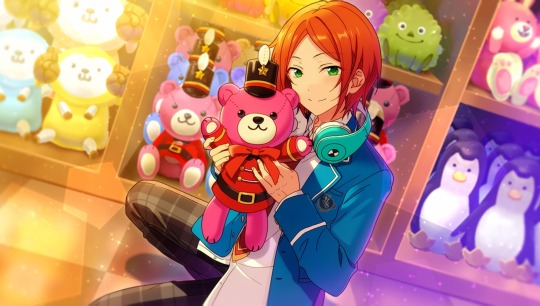
Yuuta: “Why don’t you come play with me, Princess[2]? ♪”
Touri: Who’re you calling “Princess”? …Huh?
Yuuta: “I’m happy you finally showed your lovely face ♪ I’m a teddy bear who doesn’t have a name yet. Could you give me one?”
Touri: …You’re definitely not as lovely as me. I’m not gonna fall for your tricks.
Yuuta: “Do you hate me, Princess…?”
Touri: Uuu… I know it’s Yuuta saying all this, but I can’t ignore you if you sound so sad like that~!
Uuu~... If you really, really want one, then I guess I don’t mind giving you a name!
Hinata: Yuuta-kun has successfully got him to come out. Ahaha, you’re so easy, Hime-kun~♪
Touri: Don’t call me that! Now that I think about it, you look a lot like “Momo[3]”.
Hinata: Momo? Uh, is that a cousin of yours or something?
Yuzuru: No, not a relative… You can see a soft toy sticking out of the Young Master’s pocket, yes?
He gave it the name of “Momo” and cherishes it very much.
Hmm. It seems the Young Master didn’t cause any issues while I was away on the school trip.
So perhaps I shall make the Young Master his very own “teddy bear” as a reward.
You’re also interested as well, you say, Anzu-san? Fortunately, it seems the Young Master is busy talking with the Aoi brothers, so let’s discuss the details before they notice.
← Previous Chapter ᠂ ⚘ ˚⊹˚ ⚘ ᠂ Next Chapter →
7 notes
·
View notes
Text
Folks, Nyri here, and we have just finished recording Cleyera: Conversations on Shinto, Episode 9! In which, amidst talk of Ama-no-iwato, we talk about everything from seasonal depression to impostor syndrome to parentification to Ame-no-Uzume-no-mikoto's daring delight in her breasts.
It's a bit of a ride, and will be appropriately content-warned.
Edits begin soon. Thanks for your patience.
14 notes
·
View notes
Text


Olympia Soiree — Olympia
"... Byakuya. Today is your birthday... I need you to come out of the Ama-no-Iwato."
Costume: Silentsword
Photos: Raine
2 notes
·
View notes
Note
If Ahura Mazda is Asura, and Asura is Dainichi Nyorai, and Dainichi Nyorai is Virochana, and Virochana is Amaterasu, does that mean Amaterasu is Ahura Mazda?
This logic does track with the series' own.
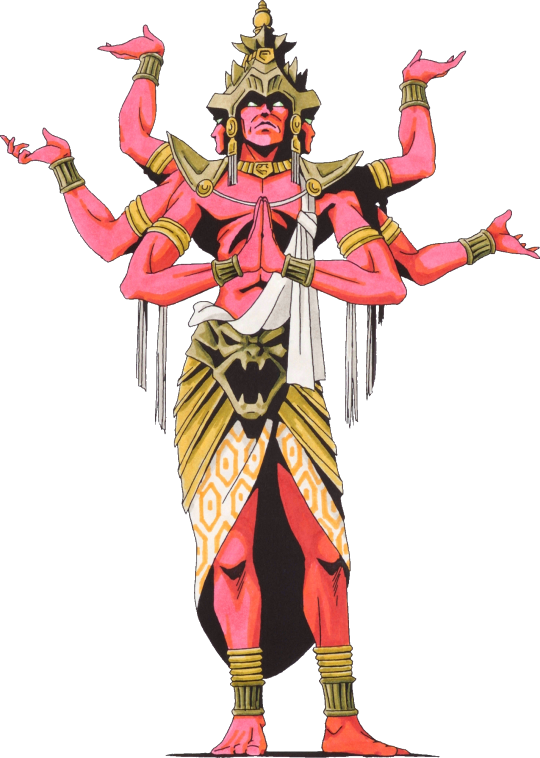


Not a great logic, mind you. And I feel they may be loathe to lump in Amaterasu in with all the "cursed by God" Asura King nonsense.
Besides, the one trick they have with Amaterasu is sealing her away, mimicking the Ama-no-Iwato.
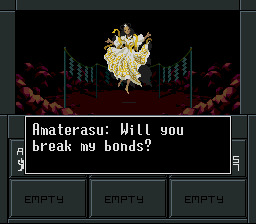
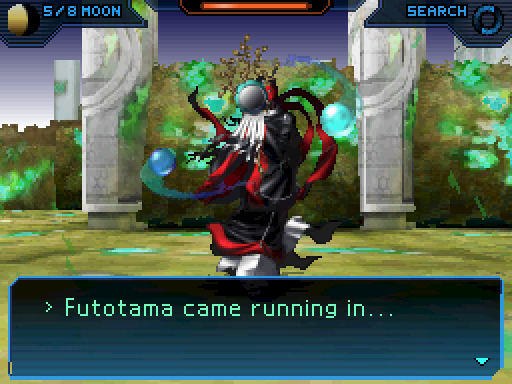
I also just noticed this in the LP:

After the Amatsu are freed, Amaterasu suggests to Hiruko that they go to the Kongokai/DIamond Realm to heal. The central deity of the Diamond Realm is none other than Vairocana! I doubt this is an Aeon Genesis invention, either.
14 notes
·
View notes
Text
Photo of the Day: Ama no Iwato
Ama no Iwato is a cave in Takachiho, Kyushu, Japan.
Although much of Japanese history takes place on the main island of Honshu, a lot of the myths and legends surrounding Japan and the Imperial Family originate in Kyushu, specifically in Takachiho.
Takachiho is where the grandson of Amaterasu Okami, Ninigi no Mikoto, descended to earth. His grandson set out with 2 other brothers from Takachiho…

View On WordPress
1 note
·
View note
Text
I found some information that I want to share about Amenokoyane and the clans that he is the ancestor of; so, I am going to translate two of the paragraphs.
Who is Amenokoyane?
This is the god who performed a special prayer in front of Ama-no-Iwato Cave, and is the god of prayers. He also accompanied Ninigi's descent from Heaven. His descendants became the Nakatomi clan, and Nakatomi no Kamatari (later Fujiwara no Kamatari), the Fujiwara clan reached its peak of prosperity. The Onakatomi Clan, head priests of Ise Grand Shrine's inner shrine, are also descendants of Amenokoyane. The Nakatomi clan is a family whose job is to mediate between the and people. It is also believed that they became the Nakatomi because they act as an intermediary between the gods.
Kotodama Faith
The scene where Amenokoyane offers prayers in front of Ama no Iwato is said to be the root of Kotodama belief. Kotodama is a divine spirit that resides in the mysterious power and function of words. You say, ``Words helped me.'' Words that act on our hearts in various ways have an impact on our hearts, for better or for worse. Kotodama belief is based on the idea that ``words have a soul and have great power,'' and it is said that words such as prayers are said to be the strongest kotodama. In that sense, chanting prayers can be thought of as an event that uses the power of words to bring good fortune and ward off misfortune. It may sound exaggerated, but it may be possible to move the world through the power of words. Amenokoyane, who has the power of words, may be the strongest god.
The Urabe Clan were descendants of Amenokoyane two, but the page doesn't mention them.
#Japanese Mythology#Amenokoyane#Ame-no-Koyane#Koyane#Nakatomi Clan#Fujiwara Clan#Fujiwara no Kamatari#Onakatomi Clan#Urabe Clan#Kotodama#Light Novel Kojiki#Kojiki#Nihon Shoki
1 note
·
View note
Text
"... in many of its [Ama no Iwato Myth] later incarnations, the myth was not primarily interpreted as a political one, but rather a metaphor for enlightenment practices, or the origination myth of performative traditions such as waka composition, Noh, and kami dancing (kagura). Only after Meiji were such interpretations purged from the historical record, in what we may understand as a determined attempt to re-establish the court's monopoly on imperial symbolism."
—A New History of Shinto, John Breen & Mark Teeuwen
Susano'o no Mikoto and Kushinada Hime and the Poem he wrote

Ama no Iwato Depiction

1 note
·
View note
Link
Earl's melons should be eaten when the color of the skin is uniform, the nets are fine and uniform, the antennae are green and they do not wilt. Pay attention to temperature and water management, and use bees for mating. In order to produce high-quality products, Earl's melons produce 1 fruit from 1 plant. Approximately 3 days before harvest, the sugar content is tested, and 55 to 60 days after mating is harvested with a target sugar content of 15 degrees. It is packed in a cosmetic box by an excellent producer and shipped after undergoing strict inspection at JA. Earl's melons in Miyazaki Prefecture are produced by utilizing the abundance of sunshine and introducing unique varieties from each JA. Varieties and cultivation methods have been established for each of the autumn, winter, spring, and summer cropping types, and it seems that they are trying to brand them by introducing high-level optical sensors. It goes without saying that the western part of the prefecture facing the Kirishima mountain range is characterized by a mild climate and has long been an area where melon cultivation has flourished.
0 notes
Text
Total Solar Eclipse: A regale of the Yayoi people, Amatsukami and Ama no Iwato
As the Total Solar Eclipse was a great event taking place across North America, I thought it would be the perfect time to write about the solar eclipse, and what it means in Shinto traditions - especially in regard to the famous Ama no Iwato myth. While it is unknown the true event associated with Ama no Iwato, it is said popularily it represents a solar eclipse – however when one studies further, a more significant connection would be to the Winter Solstice. However, indeed, solar eclipses would have most likely been significant as well, especially in relation to a recall of Ama no Iwato.

https://www.theguardian.com/science/video/2012/nov/14/solar-eclipse-australia-video
(Solar eclipse)
The myth of Ama no Iwato is centered around the Amatsukami - Heavenly kami - originally worshiped by the Yayoi people. The era in which their culture flourished and was most active is traditionally dated about 300 BC to 300 AD, called the Yayoi era (Yayoi Jidai 弥生時代). It is from this time the Yayoi people and culture shared and practiced an early type of Amatsukami worship, the spiritual tales they told immortalized today in the Kojiki. While the Kojiki was written much later, in 712 AD, there is archaeological evidence and oral tradition that these myths are much older, dating to the Yayoi, who had no writing system. So, to understand fully about this spiritual story of Ama no Iwato, and the significance an eclipse would be to them, we must talk a bit about them first.
The Yayoi people were the first to bring worship of Amatsukami to the land what we now call as Japan.
An easiest example to show the connection, as pictured below, one can clearly see the connection even in the modern era – the architecture of Ise Kotaijinguu, Amaterasu Omikami's primary shrine in the country, still retains the ancient architecture of the Yayoi people, and Yayoi settlements. (See below for comparison)
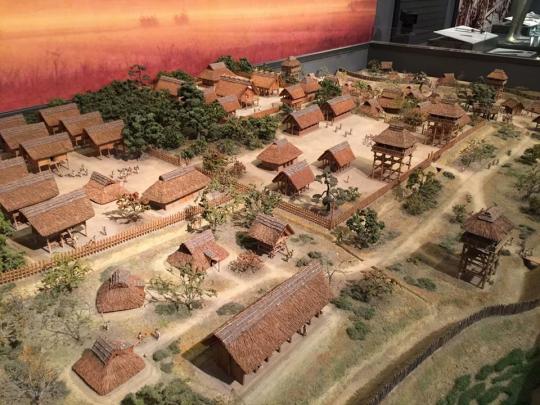
https://japanandworld.net/archives/2267
(Yayoi Settlement)

https://tapluan.wordpress.com/category/kien-truc/
(Aerial view of Ise Kotaijinguu - Naiku)
The primary Amatsukami – Amaterasu Omikami (the Sun), Tsukuyomi no Mikoto (the Moon), and Susanoo no Mikoto (storms – as well as wind, ocean, and also connected to stars). Were and are considered the Three Precious Children (Mihashira no Uzu no Miko 三貴子).
The importance of the Sun, Moon, stars, rain, ocean, and wind – and their spirits/souls, the kami, played an important part of Yayoi worship. Amaterasu Omikami being the most important to them – as she was said to be the kami who gave them life, warmth, growth, and livelihood, as well giving leadership guidance to the Yayoi leaders ( considered royalty, and were also oracles/shamans), who were usually women as well.
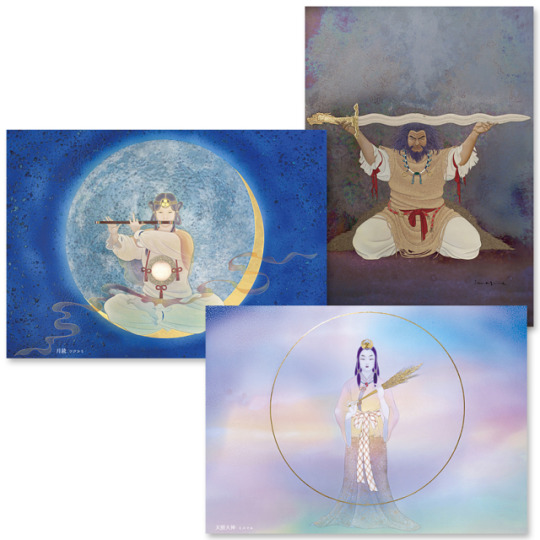
http://image1.shopserve.jp/manai.co.jp/pic-labo/llimg/p_sankishi.jpg
(Three precious children modern depiction)
Now with all this in mind, many of the Yayoi's traditions line up to the Kojiki stories of the Amatsukami. The Yayoi held the symbols of the mirror, sword, and magatama jewel in utmost respect as symbols of Amaterasu Omikami – a tradition still held today.
Common Yayoi practices, such as divination using the shoulder bone of a deer (Futomani), silk weaving, rice farming, channeling the divine via dance (miko), and so on, can all be seen reflected in the myths – especially in the Ama no Iwato myth, all these elements appear. This is why, it is important to understand the background and context of the Yayoi, to catch the nuances and importance of this myth.
I'll retell an excerpt of Ama no Iwato below, with some parts cut out in order of relevance

http://yoshitakaabe.blogspot.jp/2017/04/blog-post_72.html
(Depiction of Ama no Iwato myth)
Susanoo no Mikoto, having neglected his duties as a kami due to sadness over Izanami Okami's death, was banished from Takamagahara (realm of the Heavenly kami, Amatsukami). Distraught, he went directly to Amaterasu Omikami's palace, in order to (seemingly) seek guidance to his elder sister.
(Story of the Divine Oath)
.
.
However, while it seemed Susanoo no Mikoto had a good and pure heart, while he stayed in the palace, he committed very rude acts. In his anger and sadness, he decimated the sacred rice paddy, the farmland, and threw excrement all over the palace. The other Amatsukami were enraged and asked Amaterasu Omikami for an explanation.
She tried to defend him, saying that he was suffering through a lot of difficult emotions, and the Amatsukami begrudgingly accepted her words. She spoke to Susanoo no Mikoto afterwards, and while it was quiet for a time, he seemed to have planned and even bigger transgression.
In Amaterasu Omikami's palace, her younger sister, Wakahirume no Mikoto, was the leader of the weaving maiden kamis. She is said to be a kami of the dawn, or dusk, as well as weaving, silk production, clothing making, and related aspects. (Enshrined at Ikuta Jinja in Kobe).
As Wakahirume no Mikoto was weaving silk, Susanoo no Mikoto hid on the roof of the weaving palace. He held a skinned divine pony, and threw it harshly, crashing through the wooden/delicate roof, and landing on top of Wakahirume no Mikoto. The impact had her fall directly onto her loom with such force, that pieces of it pierced her pelvis, and she is said to have died right away. (However, later her spirit is said to have revived).
The other weaving maidens, and now Amaterasu Omikami, who had rushed in hearing the screams and crashed, saw horrific things – a skinned divine pony (said to may have been Amaterasu Omikami's own pony, which is why a white sacred horse is still presented to Naiku/Inner Shrine at Ise), ruined silk and looms (considered sacred to Amaterasu Omikami, and still offered to her at Ise Kotaijinguu), and most critically, seeing her younger sister dead.
Completely numbed and in shock, she broke down and ran with adrenaline to a cave, which we now call as the sacred Ama no Iwato, and shut herself inside.
Of course, with this, the light also disappeared, and the other Amatsukami were thrown into a panic. The weaving maidens quickly told them about the incident, and, after swiftly punishing Susanoo no Mikoto by pulling out his nails, cutting his hair and beard, and exiling him to the land of Kunitsukami, Izumo no Kuni, they began to work how to get her out of the cave.
They consulted Omoikane no Mikoto, a kami of knowledge and wisdom, to see what to do. As they made camp by the Yasu River near Ama no Iwato, he came up with a plan to call sacred and pure energy so she would want to come out, and delegated tasks to the other Amatsukami.
To Ame no Uzume no Mikoto, he suggested she do a divine dance, to call sacred energy.
To Ame no Koyane, he suggested that he write a norito prayer
To Ame no Futodama, he suggested to do the the Futomani divination with the shoulder bone of a deer (a sacred animal to Yayoi) to find out if the plan will be successful or not.
To Ishikoridome no Mikoto, he suggested she make a large mirror (now known as Yata no Kagami) so she can see her own reflection
To Tamanoya no Mikoto, he suggested they make many magatama (now known as Yasakani no magatama) to hang on the sakaki branch alongside the mirror.
Amaterasu Omikami is said to have been fond of magatama ever since the magatama necklace, Mikuratana no Kami, was given by her Father, Izanagi Okami, as a symbol to be the ruler of Takamagahara.
They also collected divine roosters, hoping their call would call her out (as roosters caw when the sun rises).
After Ame no Futodama confirmed the plan would succeed through divination, the kami began to implement everything.
It seemed to be going well, but despite the chanting of norito, and Ame no Uzume preparing a divine dance, there still seemed to be no sign of it working. All the Amatsukami were nervous.
Then, Ame no Uzume no Mikoto, the goddess of the sunrise, began to do something different. She overturned a washtub laying by the river, took sakaki and other branches and flowers in her hair and hands, and exposed her breasts. Instead of a solemn ritual to call down divine energy, she began to cheerfully and excitedly dance, and laugh, and make lots of noise stepping on the washtub and shaking the leaves.
The Amatsukami, all suddenly shocked by her actions, couldn't help but release from their tension in laughter. Once they began laughing, they couldn't stop, and Ame no Uzume no Mikoto was encouraged and began to do more and more exciting things, making the Amatsukami more and more cheerful and laughing.
At the same time, the roosters began to call, and Ame no Koyane began chanting the norito more loudly.
Amaterasu Omikami, surprised at all the sounds and noises, was shocked out of her sadness and depression for a moment. She peeked a little from the cave, and called out, “What is happening?” and Ame no Uzume no Mikoto cheerfully replied, “There's a new goddess here! And she's way better than you!” Amaterasu Omikami, shocked and confused, peeked more, whereupon she saw her reflection in Yata no Kagami.
While she was dazzled having never seen her reflection, her depression had come back, “Oh, it seems it's true, she is much better”. In this moment of remorse however, was the Amatsukami's chance. Omoikane no Mikoto called Ame no Tajikarao, the strongest of the Amatsukami, to quickly grab her out from the cave. As he did, Ame no Futodama quickly sealed the cave,said to be with shimenawa, so she could not enter again.

https://commons.wikimedia.org/wiki/File:AmanoiwatoCave.jpg
Thus, light was restored, and cheerfully the peace among the Amatsukami and Takamagahara was restored.
(What happened to Susanoo no Mikoto? He has a happy ending too, but for next time!)
From this myth, we can see important elements of Yayoi culture, such as rice paddies, farms, horses, silk weaving, and most importantly, life – all decimated. All these things would be considered very harsh transgressions against the head kami of the Yayoi people, and the people themselves. The traditional spiritual practices to commune with the kami at the time, such as Futomani, and divine dance, were credited to restoring peace, sunlight, and order. It can be gleaned that whenever transgressions against the kami happened, people reconnected to them via the leader's and their court spiritual communication with the kami to restore peace and balance.
The Ama no Iwato myth itself, as mentioned, is more associated with the Winter Solstice, especially if one considers the torii leading to Uji Bridge (Ujibashi) at Ise Kotaijinguu. This torii is the very first one that is seen before entering the sacred realm of the Inner shrine (Naiku). The way the torii is built aligns to the sun rising directly inside the torii on the Winter Solstice day. As Ise Kotaijinguu was founded by Yamatohime no Mikoto, from the Yayoi/Yamato Kingdom, and still retains Yayoi traditions throughout thousands of years, there is a connection the Winter Solstice time was a more significant event to the Yayoi (longest night of the year).
However, despite this, the time of solar eclipses relates to this myth as well albeit in a more abstract manner. The Yayoi most likely also made the connection between Ama no Iwato, the Winter solstice, and eclipses – all times when the sun's light is less, or in the case of an eclipse, slowly taken away and completely blotted out for a few minutes.
Remembering that Ama no Iwato happened due to severe transgressions - even by the divine - private rituals by the leaders, public ceremonies with the people, and extra food offerings were most likely done in order to keep the sun's light shining – to keep balance, peace, and harmony among their deities and their people.
While Ama no Iwato itself may not have been an eclipse story – the eclipse would have certainly reminded them of the myth, and to be humble and continue a proper way of living. It would have had a strong impact on them, just as it still does on us as humanity as a whole, even after thousands of years and scientific knowledge, we are still in awe at the power of great nature, and the power of the sun.
#ama no iwato#shinto#shinto mythology#shinto myth#shintoism#amaterasu#susanoo#tsukuyomi#amaterasu omikami#susanoo no mikoto#tsukuyomi no mikoto#shinto faith#shintoist#japanese culture#japanese religion#japanese history#yayoi period#solar eclipse
132 notes
·
View notes
Photo

Japanese Mythology & Deities
Major Gods in the Chronicles (32)
Ama-no-Iwato ~The legend of Amaterasu, the Sun Goddess, hiding in the rocks & darkness shrouding the world
Ame-no-Iwato (Ama-no-Iwato) is a cave made of rocks that appears in Japanese mythology.
Having won the oath with Amaterasu, Susanoo took advantage and destroyed the rice-fields of Amaterasu's own plantation, filled in the ditches, and dunged in the palace where the great tributes were taken.
Amaterasu forgave her brother's misdeeds and tried to correct his behaviour, but his misdeeds did not stop and only became worse.
Finally, as Amaterasu was folding the god's robe in her sacred workshop, Susanoo made a hole in the ceiling and dropped a skinned spotted horse through it. When the weaver saw this, she was so surprised that a shuttle bar became stuck in her pubic region and she died.
Hereupon Amaterasu, in awe, withdrew into Ama-no-Iwato, the cave. Both the high heavens and the country on earth became completely dark, and all manner of misfortune ensued.
日本神話と神様たち
記紀に登場する主な神々(32)
天の岩戸(あめのいわと)
~ 太陽神である天照大御神が隠れ、世界が暗闇に包まれた岩戸隠れの伝説
天の岩戸(あめのいわと、あまのいわと)とは、日本神話に登場する、岩でできた洞窟である。
天照大御神(あまてらす)との契約(うけい)に勝利した須佐之男命(すさのお)は、図にのって、天照大御神(あまてらす)の自家農園の田の畦(あぜ)をこわし、その溝を埋め、また、大贄(おおにえ)を召し上がる御殿に糞をした。
アマテラスは、弟の悪行を許し、彼の素行を正そうとしたが、その悪行は止まず、ひどくなるばかりであった。
ついには、天照大御神(あまてらす)が神聖な機屋(はたや)で、神さまの御衣を折らせているときに、須佐之男命(すさのお)は、その天井に穴をあけて、そこから皮を剥いだ斑馬を落とし入れた。これを見て驚いた織女(おりひめ)は梭(ひ)が陰部に刺さって死んでしまった。
ここで天照大御神は見畏みて、天岩戸に引き篭った。高天原も葦原中国も闇となり、さまざまな禍(まが)が発生した。
#japanese mythology#japanese dieties#mythology#legend#folklore#amaterasu#sasanoo#ama-no-iwato#darkness#nature#art
50 notes
·
View notes

